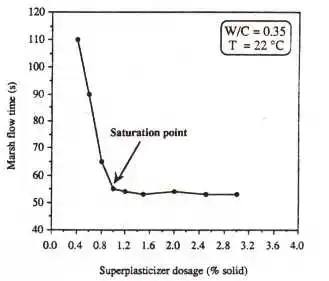Table of Contents
Plasticizers are chemical compounds that boost the production of concrete with roughly 15% less water content. Superplasticizers permit a decrease in water content by 30% or more.
There are three tests to determine the optimum dosage content. They are:
a. Marsh cone test
b. Mini-slump test
c. Flow table test
We know about the marsh cone test. The Marsh cone test is an uncomplicated test to investigate the fluidity property of cement and mortar.
1. Objective
Marsh cone test is a test carried out for discovering the optimum dosage of plasticizers and superplasticizers for various types of cement.
We know that the number of plasticizers added to concrete ranges from 0.1 % to 0.5 % of the total weight of cement.
2. Apparatus Required
Here is the list of apparatus required to perform the marsh cone test:
a. A conical brass vessel is maintained on a wooden stand with a diameter of 50 cm or 80 cm at its base.

b. Stopwatch
c. The Mortar mixer to blend the cement paste with the preferred water-cement ratio.
3. Procedure
The steps of performing the marsh cone test are as follows:
1. First make a cement paste of 1L with a preferred water-cement ratio by keeping 2 kg of cement to it.
2. While making the cement paste, the blending should be done in the mortar mixer. The mortar mixer is utilized to neglect the formation of a lump at the base of the vessel.
3. You can carry a water-cement ratio ranging from 0.3 to 0.5.
4. 70 % of water is kept at the start of mixing in the first stage and the remaining water is kept in the second stage with superplasticizers. The dosage of the superplasticizer will be 0.1 % of the weight of cement.
5. Take 1L slurry and flow it into the marsh cone by completing the aperture with a finger.
6. Begin the stop and release the finger. Note the time required measure it in seconds for the entire flow out of cement paste. This time measured in seconds is called marsh cone time.
7. Repeat the previous stages with various quantities of plasticizers with the desired water-cement ratio. The Saturation point is the dose at which marsh cone time is minimum. This dose is the optimum dose of superplasticizer of plasticizer for that brand or type of cement.
We can do this test with various types/Grades of cement and calculate the proper amount of plasticizer for a brand of cement.
4. Conclusion
From the above procedure, you can prepare a graph between marsh cone time on the x-axis and superplasticizer dosage percentage on the y-axis as shown below.

| Read Also: Flexural Strength |

